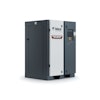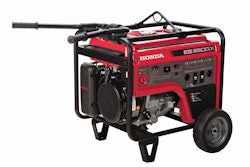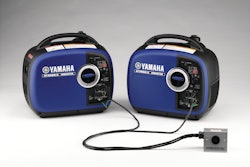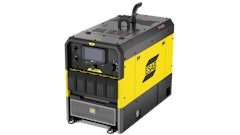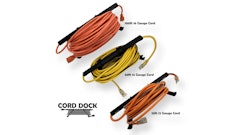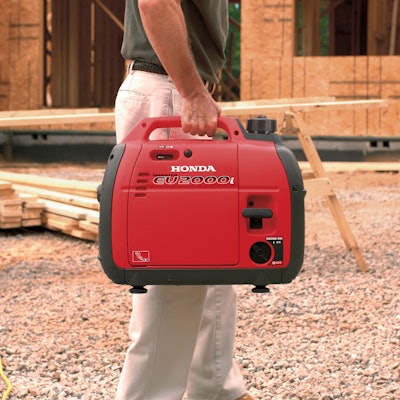
Even though inverter generator technology has been on the market since 1999, you probably aren’t aware it exists. If you happen to own one of these generators, you may not be aware that it is an inverter model, or why it is different than other generators that have served us for several decades. Hopefully, after reading this article, you will seek out inverter generators because they represent the direction that generator technology is headed in the effort to produce “cleaner power.” Today, almost all electrical equipment incorporates microprocessors requiring clean power, and inverter generator technology does the best job producing this smooth, dependable electricity.
Traditional generators
The generators we are most familiar with have three common parts: an alternator, an engine, and a control panel.
The alternator produces the electricity and has a field and an armature similar to an electric motor that produces the electricity. It is coupled directly to an engine with a governor to keep the alternator rotating at a steady 3,600 rpm in order to produce 60 hertz 120 volt current—the consistency of the current depends on maintaining 3,600 rpms. When a power tool is plugged into the generator and turned on, the engine must apply more power to the alternator in order to maintain this rpm and supply the proper current. Good generators can accomplish this very rapidly; lower quality generators have more lag time and can cause damage to equipment during this interval when uncontrolled current is generated.
Engines for generators are usually four-stroke gas powered, but there are diesel and LP gas units also. They typically operate at a set speed regardless of load while power is being delivered to equipment. Some feature idle down operation when there is no demand for power.
The third component is the control panel which contains outlets for supplying power, fuses, switches to turn the engine on and off, and other features that provide information to the operator.
Tim Sheehan, National Accounts manager for Yamaha, Cypress, California, adds that conventional generators are usually packaged in an open tubular frame for protection. The engine and alternator are exposed so there are louder noise levels as a result. This type of generator is typically used on jobsites.
How inverter generators work
Like conventional generators, inverter generators also have an engine and an alternator, or alternator-like device. Thomas Pernice, Industrial Marketing Administrator for Honda Power Equipment, Alpharetta, Georgia, says Honda introduced the first inverter generator in 1999, building the alternator into the engine’s flywheel to reduce weight and size.
Inverter generators initially create three-phase AC power which is then electronically converted to DC power by the generator’s inverter. The invertor then converts the power back to AC current with a “pure sine wave”—very high quality power suitable for use in equipment using microchips and microprocessors (in other words, almost everything we use today). Inverter generators create very smooth power, an advantage being that equipment using this power has a longer life as a result. Pernice notes that appliance dealers often see a spike in refrigerator sales (refrigerators require high quality power) after storms causing power outages because homeowners often generate temporary power with low-cost, low quality generators.
One of the great benefits of inverter generators is that they can produce current at any rpm; the engine does not have to operate at 3,600 rpm to produce 60 cycle current. The inverter electronically converts the current to 60 hertz 120 volt power. So, for instance, if you plugged in a 200-watt tool battery charger, the generator might only need to run a little faster than idle speed to produce the electricity needed; the engine rpm is adjusted to produce only the power needed by the power demand. This saves a significant amount of fuel, reduces noise, and significantly increases engine life.
Like conventional generators, the third major component of an inverter generator is a control panel which functions similarly to traditional ones.
Coupled with the fact that inverter generators often run at lower rpms, they also are usually enclosed with insulated panels, making them even less noisy.
Dual power option
Companies like Honda and Yamaha include electronics in their products, allowing you to connect two similar inverter generator units together in parallel with a wiring harness that makes it possible to power equipment with twice the wattage. By combining two, 2,000-watt generators, the output is 4,000 watts—the same as powering equipment on a 4,000-watt generator. Sheehan says people like this option because it’s easier to carry a generator that weighs 44 pounds versus one that weighs 150 pounds, and it’s easier to store them.
Pure sine waves
In the U.S., AC current changes direction by design 60 times per second, referred to as 60 hertz or 60 cycles. A graphic representation of very good power shows it as a mathematical curve of repetitive oscillation—a smooth, constant curved line on a graph; the smoother the curve the better is the power. If the curves on the graph have spikes or "blips" in the curve, it indicates a fluctuation in the power, a condition that can be harmful to both the generator and the device receiving electricity. Generator manufacturers use various means to manage this graphic curve.
Conventional generators produce a sine wave mechanically by maintaining alternator speeds at 3,600 rpm. Inverter generators maintain proper sine waves electronically and currently produce the very best power.
When power demand is too high
If you plug in too many devices or one that exceeds what a generator can supply, a spike of electricity can occur, and the resulting current can be harmful to equipment. So, generator manufacturers use electronics to shut down power output to prevent damage to equipment. Also, tools and equipment often have a greater power demand when they start up, and these “reactive loads” can require up to three times more power during the start-up phase than what is needed to run the device. This can cause generators to shut down. But there are ways manufacturers try to overcome start-up demands.
Pernice says Honda generators can run at full demand for short intervals, producing more start-up power.
Sheehan says their battery started generators can take power from the battery during start-up periods.
When demand exceeds what a generator can produce, inverter generators disengage before there is damage to tools or appliances. This usually happens while the engine is allowed to keep running.
Generator sizes
Inverter generators started with the introduction of 1000-watt units, introducing larger and larger units with time. Currently, both Honda and Yamaha offer models between that and 6,300 to 7,000 watts at the upper end.
Cost
Many contractors put cost at the top of their list, so they dismiss inverter generators because they can cost more than double that of traditional models. But, like many things, one should consider cost in terms of the life of the purchase, not just the first cost. When viewed this way, you can save money purchasing inverter generators because they consume less fuel, require less maintenance, don’t damage tools and appliances, and have longer life cycles. Sheehan says that when marketing studies are conducted, people are often asked what they owned before this purchase. “There are many low quality products mentioned,” he says. “But they buy inverter generators because they want quality and reliability.” He urges people to do their homework and make purchases based on life costs and value.
What the future holds
Inverter generator technology is the direction that companies like Honda and Yamaha are headed with their product lines because they produce very high quality current, are lighter, make less noise, and are more fuel efficient. They continue to introduce higher and higher wattage inverter generators. The need for cleaner power also is being driven by tools and equipment that depends increasingly on microelectronics.
In the future, will there come a time when generators are no longer needed? With the rapid growth in battery technology, Pernice wonders if batteries will be combined with inverters to produce power for jobsite needs. The future will probably include fuels other than gas and diesel too—perhaps even fuel-cell generators which have no moving parts.




